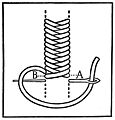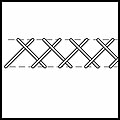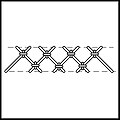Cross stitches



Cross stitches in embroidery, needlepoint, and other forms of needlework include a number of related stitches in which the thread is sewn in an x or + shape. Cross stitch has been called "probably the most widely used stitch of all"[1] and is part of the needlework traditions of the Balkans, Middle East, Afghanistan, Colonial America and Victorian England.
Applications
Cross stitches were typical of 16th century canvas work, falling out of fashion in favor of tent stitch toward the end of the century.[2] Canvas work in cross stitch became popular again in the mid-19th century with the Berlin wool work craze.
Herringbone, fishbone, Van Dyke, and related crossed stitches are used in crewel embroidery, especially to add texture to stems, leaves, and similar objects. Basic cross stitch is used to fill backgrounds in Assisi work.
Cross stitch was widely used to mark household linens in the 18th and 19th centuries, and girls' skills in this essential task were demonstrated with elaborate samplers embroidered with cross-stitched alphabets, numbers, birds and other animals, and the crowns and coronets sewn onto the linens of the nobility. Much of contemporary cross-stitch embroidery derives from this tradition.
Variants
Common variants of cross stitch include:[3][4]
- Basic cross stitch
- Long-armed cross stitch
- Double cross stitch
- Italian cross stitch
- Basket stitch
- Leaf stitch
- Herringbone stitch
- Closed herringbone stitch
- Tacked herringbone stitch
- Threaded herringbone stitch
- Tied herringbone stitch
- Montenegrin stitch
- Trellis stitch
- Thorn stitch
- Van Dyke stitch
Gallery
-
Basic cross stitch as worked in embroidery
-
Long-armed cross stitch
-
Double cross stitch
-
Italian cross stitch
-
Basket stitch
-
Leaf stitch
-
Herringbone stitch
-
Tacked herringbone stitch
-
Tied herringbone stitch
-
Montenegrin stitch
-
Thorn stitch
-
Trellis stitch
-
Van Dyke stitch
See also
Notes
- ^ Gillow, John, and Bryan Sentance: World Textiles, Bulfinch Press/Little, Brown, 1999, ISBN 0-8212-2621-5, p. 181
- ^ Levey, S. M. and D. King, The Victoria and Albert Museum's Textile Collection Vol. 3: Embroidery in Britain from 1200 to 1750, Victoria and Albert Museum, 1993, ISBN 1-85177-126-3
- ^ Gillow and Sentance: World Textiles, p. 180-183
- ^ Reader's Digest Complete Guide to Needlework. The Reader's Digest Association, Inc. (March 1992). ISBN 0-89577-059-8, p. 38
References
- Caulfield, S.F.A., and B.C. Saward, The Dictionary of Needlework, 1885.
- Enthoven, Jacqueline: The Creative Stitches of Embroidery, Van Norstrand Rheinhold, 1964, ISBN 0-442-22318-8
- Reader's Digest, Complete Guide to Needlework. The Reader's Digest Association, Inc. (March 1992). ISBN 0-89577-059-8
- Lemon, Jane, Metal Thread Embroidery, Sterling, 2004, ISBN 0-7134-8926-X, p. 112
- Levey, S. M. and D. King, The Victoria and Albert Museum's Textile Collection Vol. 3: Embroidery in Britain from 1200 to 1750, Victoria and Albert Museum, 1993, ISBN 1-85177-126-3














